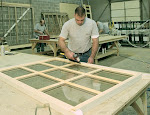Thursday, September 6, 2012
Let's Not Get Too Testy
Testing in the fenestration industry has been practiced for many decades especially in the commercial sector. It has long been a common practice to conduct mockup tests on custom curtainwall designs that are project specific prior to fabrication and installation. These tests assure that the details as designed will perform as intended under the harsh realities of Mother Nature. The industry has also accepted testing of new window and door products to equip the consumer with an understanding of what they are actually purchasing. There is a big difference in structural, thermal, and air/water infiltration ratings for the hundreds of different window designs made from steel, aluminum, wood, vinyl, and fiberglass. Testing of these products enables one to determine the differences between various products. Architectural window testing has served the industry well in defining performance, influencing design, and establishing quality control. It is only natural, therefore, to be tempted to apply standardized tests to existing historic wood and steel windows for a preservation project. For this to be a rewarding experience, however, one must think before applying a boiler plate testing standard to a preservation project.
There are several agencies and organizations that are involved in the testing of windows and doors such as American Architectural Manufacturers Association (AAMA), American Society for Testing & Materials (ASTM), Window & Door Manufacturers Association (WDMA), Canadian Standards Association (CSA), and the American National Standards Institute (ANSI). ASTM for instance has drafted testing methodologies for windows and doors that evaluate specific performance metrics for the specimen. For example, an ASTM E2068 rates the force required to open a window, ASTM E283 tests for air infiltration, and ASTM E547 evaluates the water resistance of the window system. These agencies often work together in defining new standards. Back in 2008, AAMA, WDMA, and CSA combined to draft a standard that is widely used in North America called the 101/IS.2/A440. A full battery of tests on a window will include evaluating the window’s resistance to forced entry, structural integrity, deflection of the window under structural loads, resistance to water and air, and the force required to open the window.
So if these agencies have contributed so much to understanding the integrity of newly manufactured window systems, one would think that you should be able to incorporate similar testing towards the evaluation of historic wood and steel windows. Unfortunately, that isn’t always the case. Most historic wood and steel windows that were manufactured 75+ years ago were not designed to pass modern-day testing standards. That doesn’t mean they are unsuitable for the structure, it just means they won’t pass many of the current test standards. Air infiltration and water resistance testing are most commonly requested on historic windows. I will save you $4,000 and a lot of headaches by informing you that a 75 year old wood double hung will fail an AAMA 502 water test. You can minimize this effect by installing storm windows, but a redesign of the sill and weather stripping must be done if you are going to achieve modern performance levels on a water test. It is important, therefore, to understand what are the realistic performance expectations of your existing historic windows prior to considering applying a testing criteria to the project.
There are situations where testing of historic windows makes sense. We have found testing to be very valuable when you have a situation where the entire window system must be replicated. In these cases where everything is going to be replaced with a custom, one-of-a-kind window, this distinct design should be tested. Re-View has manufactured thousands of complete replica window units that match the original drawings of a historic building. We recommend testing any new design that hasn’t be subjected to the testing criteria in the past as a means to insure that the product engineering performs as anticipated. Since the tests are designed to subject the window under peak stress conditions, product design deficiencies quickly rise to the surface. We learned a great deal about adapting the design of the sash, glazing, frames, finishes, and weather stripping as a result of our many test experiences.
I thought it might be helpful if I shared some actual lessons we learned while testing windows over the years:
• The area where our frame jambs meet the sill had to be completely redesigned after a test many years ago because water penetrated this joint. Originally our means of sealing this joint was similar to very widespread industry practices. If it weren’t for the water test, we wouldn’t have known that this joint is a common weakness in many window designs.
• One would think that windows fabricated by large international manufacturers would easily pass a random water test, but we had catastrophic failure on a field test of a frame design of a standard product offering from one of the largest wood window manufacturers in the world. So don’t completely trust published testing statistics on existing designs.
• We have experienced immediate failure on water testing of standard historic double hung windows because the rise in the sill isn’t high enough to withstand the rise in the water when it is put under pressure during the test. That is why you see modern windows with a sill design that rises above 1-1/2 inches.
• We experienced glazing leakage very early in our history during a test that influenced a total redesign of our glazing design and methods of application. The results of this test inspired us to invest in automated glazing equipment, purchase different types of sealant, and redesign the glazing rabbit on our sash.
• We discovered that ballistic glass will fail if you hit the same area with a second round.
• Our engineering team enjoys pushing the tests beyond the standard criteria. It is quite common for us to take the tests to another level to push the window to a point of failure. We have learned a great deal about structural issues and water penetrations by amplifying the testing way beyond the published standards. It can be pretty alarming to see a massive window specimen literally blow up before your eyes when exposed to pressures many times the test standards.
• We conduct accelerated testing of paint finishes whenever we evaluate a different species of wood or alternative finishes. We also incorporate adhesion testing of field applied finishes as a quality control mechanism. Our plant uses non-destructive paint mil thickness testing as another QC tool.
Take a look at our Facebook page to see pictures of many of the tests we have conducted on our historic window designs in the past:
https://www.facebook.com/media/set/?set=a.405489146173765.95095.118211914901491&type=1#!/media/set/?set=a.405489146173765.95095.118211914901491&type=1
Subscribe to:
Post Comments (Atom)






No comments:
Post a Comment